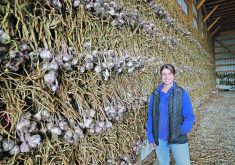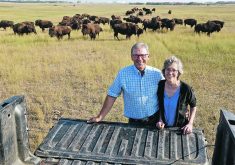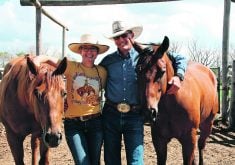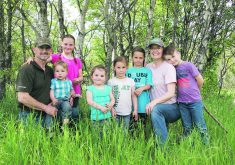MAGALIESBURG, South Africa —Experts have credited South Africa with having all the major ingredients to produce food that can feed the rest of the continent and other parts of the world.
Bosparadys Farm is near Magaliesburg and run by the Khourie family, which includes William and his sons, Joe, Anthony and Pieter, who all take charge of various enterprises.
Dairying is the dominant business, accounting for 80 percent of the total farm income, but the Khouries also produce sheep, pigs, hens, goats and game.
They have farmed there for more than 20 years and have built up a profitable business with total farm income of about $19.3 million.
Read Also

Fuel rebate rule change will affect taxes and AgriStability
The federal government recently announced updates to the fuel rebates that farmers have been receiving since 2019-20.
The family owns 5,000 acres and rents a further 1,200 from a local landowner. Around 1,000 acres of this land are planted in grasses and 2,700 acres are used to produce corn silage averaging 5.6 tonnes per acre.
The remainder is natural land used for game farming.
Anthony Khourie is in charge of feed planning and production, and runs a stable feed bank for dairy production. Joe manages the dairy herd and the heifer herd while Pieter is the overall marketing manager for the farm.
Bosparadys Farm milks 800 cows with an average yield of 30 litres per cow per day but it has a high yielding batch of 250 cows producing 40 litres per day.
The high yielders are milked three times per day in the 14/28 herringbone milking parlour while the rest are milked twice per day.
“Our farm currently averages milk quality of 3.3 percent protein and 3.6 percent butterfat that is quite important as we bottle our own milk and produce yogurt, cheese and buttermilk on site as well,” said Anthony.
“In total, the farm’s daily production of 24,000 litres is used in our on-site factory together with an additional 26,000 litres that we buy in each day from a local supply network of 12 other dairy farmers.”
Liquid milk accounts for 85 percent while 12 percent is made into buttermilk and three percent goes into yogurt and cheese.
Other dairy livestock includes 200 dry cows, 150 bred heifers aged up to two years old and 420 young heifers from birth to 15 months old.
Artificial insemination is used on the older cows, using Dutch sires. The younger heifers run with groups of young Holstein bulls.
The business operates its own fleet of delivery trucks that deliver the milk to a network of 200 shops and supermarkets.
Milk is most popular with customers when sold in two litre containers, which sell in the shops for around $2.41. The farmer receives 96 cents per litre for the milk and his cost of production is 39 cents per litre.
The dairy cows are kept outdoors in corrals and are fed according to yield, with the majority being fed to produce 30 litres per day,
“Cows are fed 38.9 kilograms of a total mixed ration per day using our own feed mixers. The ration contains 2.3 kg grass, 6.7 kg brewers grain, 17.7 kg of maize silage, 6.3 kg of a 28 percent high protein content supplement and 5.9 kg of maize meal,” said Anthony.
“This ration costs 69.34 rand ($6.69) per cow per day and equates to a feed cost per litre of 2.72 rand (26 cents),” he said.
The Khourie family employs 250 staff who work in all the sectors on the farm. The dairy factory operates on two shifts almost 24 hours per day, with a more relaxed timetable at the weekend.
The farm also runs 22,000 hens, 100 pigs, 1,000 ewes, 300 goats and a tourist holiday park.
A herd of 1,000 Suffolk ewes produces meat lambs. All the ewes lamb outdoors with a lambing percentage of 150 percent.
Using Suffolk with the traditional black pigment colour in its face means less eye problems.
“Rams run with the sheep outdoors from November to December to allow for lambing in May. Lambs are reared to 40 kg liveweight and are then sold for meat at around ($2.89) per kg.
“The sheep graze on rougher pastures and are rotated every three weeks but are allowed to feed in the maize fields once we finish harvesting in April to clean up any surplus silage and maize stocks.
“One of the major threats to the lambs is the jackal, which kills them, but there are some diseases including bluetongue, Rift Valley Fever and pulpy kidney that we vaccinate for.”
Pigs are purchased as weaners weighing 15 kg for $28.95 each. They are then primarily fattened on the waste dairy produce and are sold at 45 to 50 kg for $115.79.
There are 20,000 laying hens on the farm, with eggs sold in the same retail outlets as the dairy products.
Anthony’s wife, Nina, helps to look after this enterprise.
“We use the Hyline Red and White breeds as we receive a higher income from those breeds when they are being sold after their laying term finishes, usually after one year,” she said.
“The birds are purchased in at 20 weeks of age as laying pullets and reach their laying peak at 30 weeks with a 95 per cent laying rate.”
The Khouries have found that the most profitable period to keep the birds within is around a year old, while maintaining an average 85 percent laying rate.
“Eggs are collected twice per day from the cages and are marketed according to their size with the large ones measuring 30 to 40 millimetres commanding an income of 15 rand ($1.45) for one dozen. The retail outlets will add on its margin and sell the eggs for 24 rand ($2.32),” said Nina.
“When the hens arrive on the farm they are fed phase one starter feed with 16 percent protein content. Later in phase two they are fed a lower percentage protein feed, which is cheaper to buy.
“All the feed is purchased but if the farm has any surplus maize from the dairy enterprise we mix it with a high protein content supplement and feed to the birds.
“The manure produced by the birds is used to fertilize the grassland pastures with additional assistance from some 28 percent nitrogen bag fertilizer that is bought in,” Nina said.















